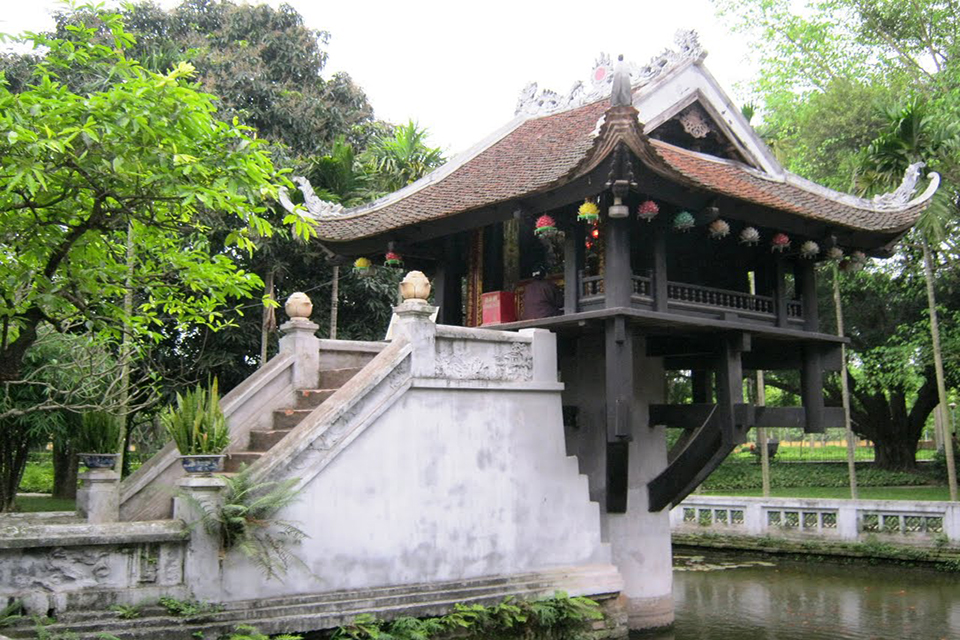One Pillar Pagoda is an extremely unique ancient temple in Vietnam. Not only is the symbol of the Hanoi capital for thousands of years, but the unique architectural design of the One Pillar Pagoda is also the pride of the Vietnamese people with international tourists on street food tour in hanoi.
The pagoda has a very unique architectural design with a square structure on a stone pillar, below it is a lake, above is wooden bars that make up a frame to solidly support the temple, like a lotus flower sprouting from the lake surface. See details at Image of One Pillar Pagoda.

One Pillar Pagoda – a long-standing historical and cultural relic
One Pillar Pagoda is one of the beautiful tourist spots in Hanoi with a history of thousands of years of culture of Thang Long. The pagoda was built after a dream of King Ly Thai To.
According to Dai Viet Su Ky Toan Thu recorded, King Ly Thai To, after dreaming, saw Buddha Guan Yin on the lotus bring him to the lotus. Feeling a dream as a prophecy of Buddha Guan Yin wanted to send to him, the king decided to consult the monks in the citadel.
Zen Master Tue after hearing this dream, advised the king to built a pagoda on the lake surface, built a stone pillar in the middle of the lake as a lotus pagoda for Quan Am Buddha as a dream.
The temple One-Pillar architecture is a new style unprecedented in the history of Vietnamese Buddhist architecture. But according to Buddhist studies, the design of the One-Pillar Pagoda looks very much like a pillar of Buddhist scripture, erected to create merit.
When the pagoda was completed (the Year of the Ox – 1049), it was extremely beautiful and solemn. From a distance, the pagoda is like a thousand-petal lotus supporting a buddha pagoda, inside a golden statue of Guan Yin.
On the day of the inauguration of the pagoda, monks came for chanting for the king, blessing for the people. To create merit, every 8th in the fourth lunar month, the king and the people came to bathe the Buddha, Life release and pray for the people. The king stood on the platform high in front of the temple and released a bird fly away.
The pagoda was restored by King Ly Nhan Tong and expanded in 1106, creating a vast complex of pagodas and temples.
After many years of ups and downs with the capital, in 1954, the pagoda was destroyed by French colonialists, leaving only pillars and wooden support beams. The temple is now built on the old pillar of the old One Pillar Pagoda, according to the Ly dynasty’s Buddhist architecture, simple but solemn.
One Pillar Pagoda – the most unique temple in Asia
Although it is only a reconstruction based on the architect of the ancient Dien Huu Tu (The ancient name of One Pillar Pagoda in Ly Dynasty), the One Pillar Pagoda still bears the image of a large pagoda that used to be the place where the King organised Buddha bathing and life releasing.
The pagoda still retains the shape of the lotus, including a square structure made of wood, each side is 3m long, has 4 roofs, 4 heads are arched with dragon’s shape, and the roof is covered with tiles. Under the pagoda is a wooden supporting system with a pillar.
Although the pagoda today is not shaped like the lotus petals on a stone pillar like the ancient One Pillar Pagoda, in the eyes of tourists travelling Hanoi street food walking tour and the people of the capital, a pagoda is located in the middle of the water like a noble and beautiful lotus still exists and lies in the middle of this lake.
Creating a lotus shape is a unique feature of the architecture of One Pillar Pagoda. Designing the temple stand on a column that was almost impossible to achieve was built by architects in the past thanks to the extremely perfect structural solutions.
Thanks to the bold and meaningful design, the One Pillar Pagoda is recognized by Guinness Book of Records as the most unique pagoda in Vietnam. Foreign tourists on hanoi food tours visiting the One Pillar Pagoda are impressed with the unique architecture of the temple.
For more information/details: Hanoi street food, Hanoi traditional food, Vietnam food tours, food walking tour, Vietnam cooking class

